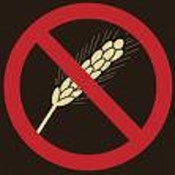Among those who suffer from allergies or sensitivities to specific foods, one of the more challenging food sensitivities is intolerance to gluten. Gluten is a combination of two proteins, gliadin and glutenin, found in certain grains (including wheat, barley, rye and oats). Gluten's function is to form a sticky protein that provides the elasticity and structure to baked breads. It is the gliadin portion in gluten that elicits the allergic response, which varies in severity and manifestation of symptoms in those with this condition. The only treatment is complete removal of gluten from the diet, something that can be nearly impossible to achieve.
The gluten response
Although the body's response to gluten sensitivity is an autoimmune reaction, it is not considered a true allergy, but rather is usually referred to as "gluten intolerant enteropathy" or celiac disease and is characterized by damage to the small intestine. It is thought that the increased permeability of the gut lining allows gliadin entry into the intestinal lamina, thereby triggering release of antibodies and inflammatory responses. Repeated insult by gluten ingestion further damages the intestine, causing lesions and villi atrophy. This can lead to many problems including malabsorption, and if in a child, failure to thrive. Some of the most common symptoms are indigestion, abdominal bloating, and diarrhea.
Who has it?
Once thought of as uncommon in the U.S., celiac disease is now believed to occur in 1 in every 133 people. Because the symptoms of this disease can be similar to other gastrointestinal diseases, it can be easily misdiagnosed, meaning it may be even more common than the numbers show. Celiac disease is thought to be a genetic disorder which can be diagnosed early in some children; however, others may not experience it until much later in life. Having an environmental trigger is believed to be an important component of the disease. Possible triggers include viral infection, parasites, or recent surgery.
Diet - the only treatment
The sole treatment for gluten intolerance is complete and permanent removal of all gluten from the diet. Although the severity of the intolerance varies, some individuals can't tolerate even a molecule of gluten. This means avoiding anything made with wheat, rye, barley and oats. The most obvious foods to eliminate are baked goods such as breads, cakes, cookies, muffins, pancakes, and crackers. Less obvious ones are tortillas, pasta, cereals, and snack bars. Diligent label reading is necessary because even small amounts can be found in unsuspected food sources. For example, wheat flour is frequently added as a flow agent to seasonings and spices or as a thickener to soups and condiments. Gluten is also added as stabilizers in hot dogs, cold cuts, sandwich spreads, and canned meats.
Other diet challenges…& what about oatmeal?
Even though it is pretty clear which grains need to be avoided by persons with celiac disease, there are still some grains in question. One of these is oatmeal. Current research is inconclusive regarding tolerance to oatmeal. Results range from completely intolerant, ability to tolerate some, to completely tolerant. One concern with oatmeal and other products, is cross contamination. When the oatmeal is processed in the same place as wheat it is possible to become contaminated with gluten. This cross contamination issue can apply to restaurants too. Even though a dish might be made with gluten free ingredients, it could still be cooked on the same grill as wheat battered fish.
Gluten-free products
Fortunately, gluten-free foods are now available at health food stores and even some major grocery stores. Alternative grains like rice, corn, quinoa, amaranth, or millet are being incorporated into gluten-free pastas, cereals, snacks bars and baking mixes, to mention a few. These products can be expensive so learning to cook gluten-free is also an option. Wheat flour can be substituted with many other flours such as amaranth, rice, sorghum, and soy flours. Baking with other flours takes a little more work than simply switching out wheat for the alternative flour, but there are several cookbooks and websites with gluten-free recipes to help out.
One cookbook, Cooking Gluten Free is available from Utah State University Cooperative Extension.
A class on gluten free cooking will be tuaght by CCEFM Nutrition Program Educators on Tuesday, March 16th from 6:00 – 7:30 pm in our Extension Teaching Kitchen at 55 East Main Street, Lower Level, Johnstown. Note the box on the right for registration information. Extensive lists of foods to avoid and acceptable alternatives can be found on celiac association websites and organizations, such as those listed below.
American Celiac Society
P.O. Box 23455
New Orleans, LA 70183
Ph. (504) 737-3293
Fx. (504) 737-4283
Email: amerceliacsoc@netscape.net
Celiac Disease Foundation
13251 Ventura Boulevard, #1
Studio City, CA 91604
Ph. (818) 990-2354
Internet: http://www.celiac.org
Celiac Sprue Association
P.O. Box 31700
Omaha, NE 68131-0700
Ph. 1-877-CSA-4CSA
Internet: http://www.csaceliacs.org
Gluten Intolerance Group of North America
15110 10th Avenue, SW., Suite A
Seattle, WA 98166
Ph. (206) 246-6652
Internet: http://www.gluten.net
Source: Colorado State University Extension
Edited by: Stephanie Wallner, M.S., Mary Schroeder, M.S., R.D, Pat Kendall, Ph.D., R.D., Colorado State - Fall 2006







